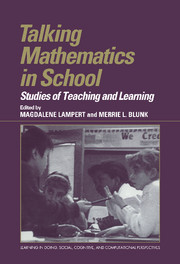Book contents
- Frontmatter
- Contents
- Series Foreword
- Acknowledgments
- List of Contributors
- 1 Introduction
- Part I Doing and Learning Mathematical Talk
- 2 Language Socialization in the Mathematics Classroom: Discourse Practices and Mathematical Thinking
- 3 The Role of Imagery and Discourse in Supporting Students' Mathematical Development
- 4 Building a Context for Mathematical Discussion
- 5 Disciplined Perception: Learning to See in Technoscience
- Part II Teaching Mathematical Talk
- Afterword
- Author Index
- Subject Index
4 - Building a Context for Mathematical Discussion
Published online by Cambridge University Press: 04 August 2010
- Frontmatter
- Contents
- Series Foreword
- Acknowledgments
- List of Contributors
- 1 Introduction
- Part I Doing and Learning Mathematical Talk
- 2 Language Socialization in the Mathematics Classroom: Discourse Practices and Mathematical Thinking
- 3 The Role of Imagery and Discourse in Supporting Students' Mathematical Development
- 4 Building a Context for Mathematical Discussion
- 5 Disciplined Perception: Learning to See in Technoscience
- Part II Teaching Mathematical Talk
- Afterword
- Author Index
- Subject Index
Summary
A question that the mathematics education community is currently addressing is how to design mathematics classroom instruction that supports and encourages students' active, authentic engagement in the construction of mathematical knowledge. Creating authentic problems is one strategy that is often considered in this respect; however, authentic mathematical activity involves more than just the kind of problems students may be given to solve. We also need to consider the cultural authenticity of classroom instruction. Authentic mathematical activity involves students' adopting perspectives, beliefs, values, and expectations consistent with those of the mathematics community, and using these to analyze a problem situation with respect to their existing mathematical knowledge and experiences.
A major part of doing mathematics involves interpreting situations according to the cultural norms established by the mathematics community. To the extent that students are able to use these norms to analyze situations and to create the problem-solving contexts that they work in, their participation in mathematics classroom knowledge-construction activities can be said to be more or less authentic. While mathematicians may work in a context first established by other mathematicians, possessing the skills necessary to create a mathematical context is a necessary requirement for interpreting the quality and validity of such a prefabricated context. Traditional mathematics instruction typically provides the goal and the numbers and simply requires the student to execute a procedure selected from a restricted set of options (Cognitive and Technology Group at Vanderbilt, 1993).
- Type
- Chapter
- Information
- Talking Mathematics in SchoolStudies of Teaching and Learning, pp. 82 - 106Publisher: Cambridge University PressPrint publication year: 1998



